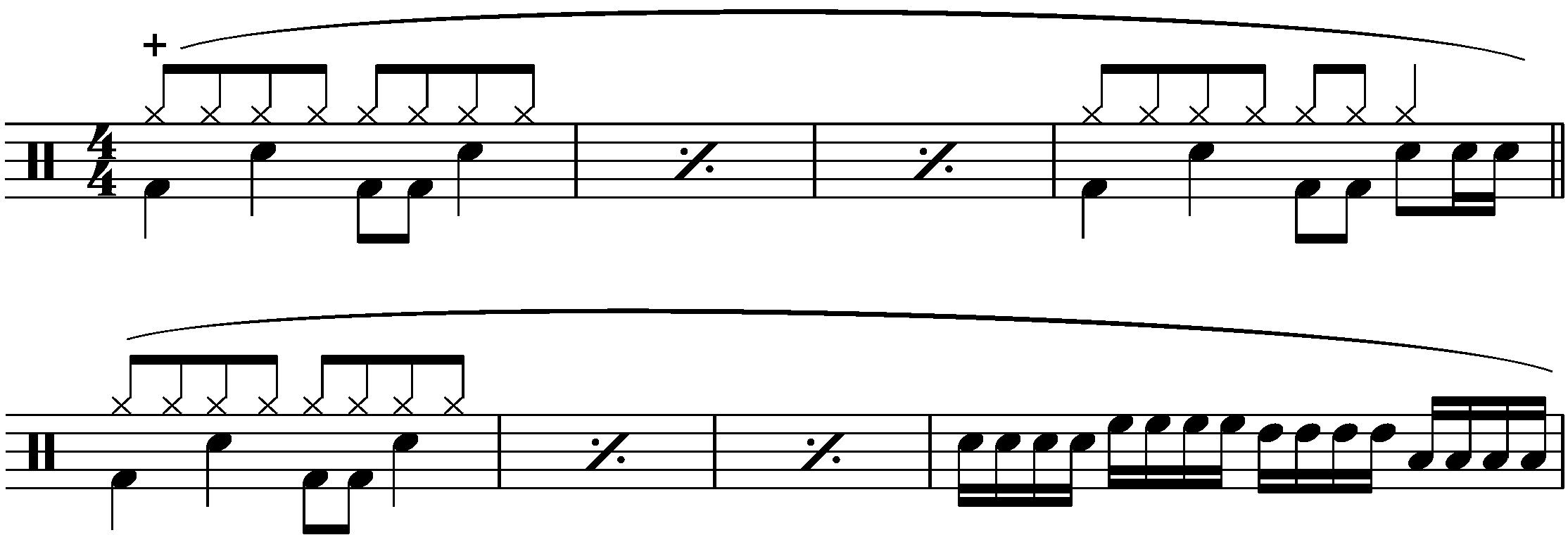Learning how to play a fill is really only half of what you need to know, being able to use fills appropriately is equally as important. Whilst there are no strict rules of when and where to play fills in a piece or song there are some guidelines that can be followed.
We said in an earlier lesson that a fill can be used to signal a change between sections of music. So one of the most common places you will see a fill is in the very last bar of a structural section (verse, introduction, chorus etc...). For example the last bar of a verse to lead into a chorus.
The example below is an extract from the song 'Fortunate Son' by Creedence Clearwater Revival. It shows the last line of the introduction and the first line of the first verse. Notice that in the very last bar before the verse starts, a fill is played. You can see the structural sections in the left hand margin, in. is intro and v.1 means verse 1. The double bar line used at the end of the first line tells us that the current section has ended and a new section will start on the next line. Remember, the percentage sign means play the bar before again.

This idea of playing a fill before a change in structural sections highlights another important role of a drummer. Not only does this fill signify to the listener that the musical section is going to change but it can also act as a musical queue to remind the rest of the band of what is about to happen.
This concept is often expanded on to signify the end of a phrase. For example, music is usually made up of different sections like verses and chorus's. Each of these in turn is built from smaller sections that are repeated several times. These smaller sections can have many descriptions such as riffs, chord progressions or phrases. A fill is often put at the end of each repetition of these phrases.
Below is an example of how this might look when used in a song. In this example we can pretend we're looking at a verse and this verse is made of a four bar phrase that is repeated. As before, at the end of the section in bar 8 we have a fill. Now there is also a shorter fill in the fourth bar, where the first phrase ends. So different fills have been used here for different purposes. The curved lines over the top of the stave are 'phrase marks' which indicate where musical phrases occur:

At the moment this may sound quite complicated but it will very quickly become second nature to you. The key thing to remember is to listen to the other instruments and get an idea of both the main structure of the song as well as the structure of the individual sections. You can then work out where to place your fills based on this information.
The final use of fills is as a form of musical decoration. These kinds of fills range from being very intricate and musical fills that follow another instrument to being seemingly a random array of notes played at lightning speed. As with most things we've discussed so far, there will usually be some logic to the parts and the trick is always to try and work out what it is. There will be several lessons on this in up coming lessons.
TASK
- Have a look at our score for Stop And Stare by One Republic. Note the use of fills as both phrase endings and before section changes. Listen through this song and work out both layers of structure. Try and get an understanding of how the fills work then learn as much as you can.
- Using manuscript paper write out a drum part for an imaginary song that is just made up of a verse and chorus.
- Listen to further songs noting the placement of fills.
I recommend trying our Full Bar Eighth Note Fills or Half Bar Eighth Note Fills next.

